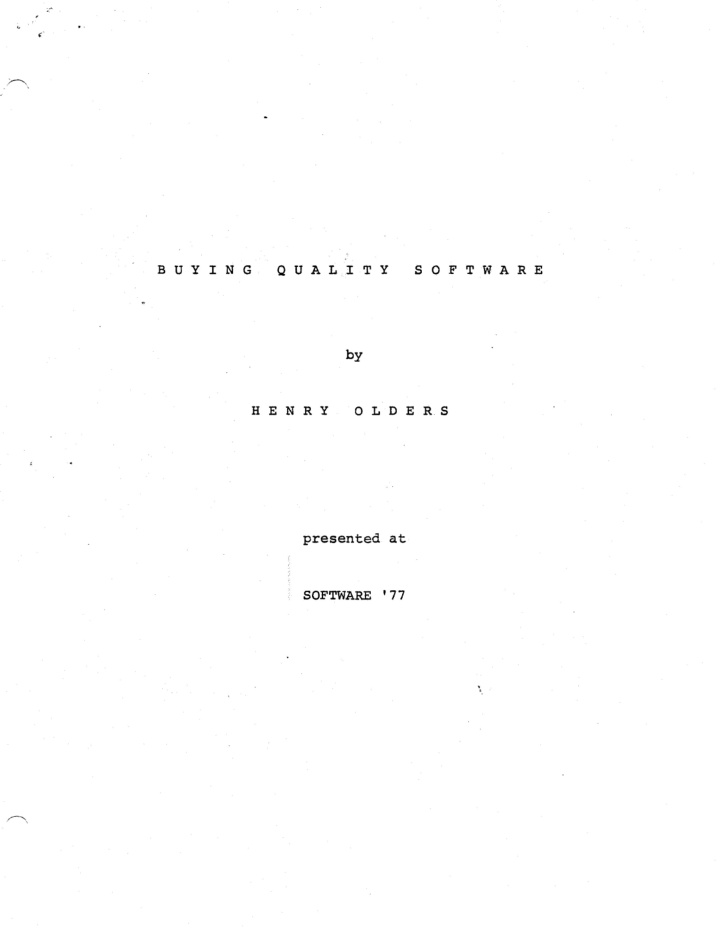



B U Y I N G Q U A L .. I T Y SOFTWARE by HENRY OLDERS presented at SOFTWARE '77
-~ B U Y I N G QUALITY SOFTWARE The author describes his experiences in purchasing applications software for real time process control systems. The project is Montreal MAPP (Major Postal Plants), which are large, automated mail processing plant housing seventeen computer-controlled conveying systems and ;" sortation machines. supervisors contr<;>l each of these systems via CRT terminals which conununicate with seventeen pairs of minicomputers. The DEC PDP-11/34 minicomputer pairs are interconnected in a dual-redundant configuration. The government purchased all these computers, complete with peripherals, digital I/O and operating system software, from one vendor, and then distributed pairs of computers to five different software houses. These houses are subcontractors to a number of mechanical contractors, who in turn are the "primes" for the seventeen process systems. Each prime contract is essentially a performance contract; that is, the specification describes how the process system must perform. The design details required to meet the specified performance are the contractor ':s responsibility. As a natural extension of the quality assurance requirements which apply to the mechanical systems, a program of quality assurance for the software being purchased was initiated by the Department of Supply and Services, the contracting agency for the project. The software QA program is bas~d on a working definition for quality software. According to this definition, a program is of acceptable 1
quality if it meets the following four criteria: 1. the program performs according to its specification 2. it is delivered according to schedule 3. its cost when delivered has remained within acceptable limits 4. it is maintainable (i.e.: understandable and well documented) A five-point strategy for purchasing software was adopted. The goal of this policy is to ensure that the software supplied is of acceptable quality, as outlined earlier. The five points are: 1. Ensure that software suppliers have a software QA program; 2. Require suppliers to make documentation deliveries at intermediate points in their development process. Make milestone payments for these deliveries. 3. Carry out software QA audits on a regular basis. 4. Attend the preliminary and critical design reviews carried out by the suppliers. 5. Have the suppliers generate detailed schedules and monitor these closely. The software milestone payments (point 2 of the purchasing strategy) are intended to stimulate the suppliers to carry out their software production in an orderly sequence, as well as provide a mechanism for feedback between the customer and the suppliers about·the design, at early stages of production. The milestones that are called up by the contract specifications are: 1. An interim version of the user manual; 2. A system overview (description of module groups and data bases); 3. Test procedures and test data for module or integration testing; 4. Program flowcharts; 5. Source listings. 2
The third point of the purchasing strategy, QA audits, are based on a checklist that is devided into three sections: QA program and management, procedures and standards, and procedures compliance. Although the purchasing strategy is now reasonably well defined, it evo1ved from a situation in which contracts had been let prior to detailed consideration being given to providing for quality in the software being purchased. A number of problems have been encountered in the application ·of this purchasing strategy. - the five software houses did not have an organized QA program; - the specification requirements for software milestones were poorly specified, and wel:'e misinterpreted by vendors in some cases; - a shortage of manpower in the project office for reviewing milestone submissions, thus increasing the turnaround time. the software houses were unable to provide detailed schedules for their software production. This problem was resolved by having the project office provide expertise to the vendors to assist them in generating schedules. - no initial participation in design reviews. This allowed a number of problems relating to design of system architectures to remain below the surface until quite recently. Results so far indicate that the purchasing strategy can be effective, if some adjustments are made in the methods for its application. 3
Recommend
More recommend